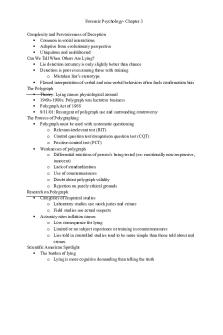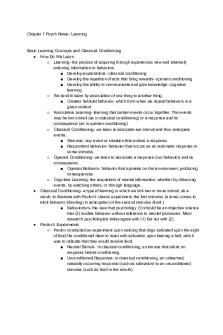Chapter 7 psychology PDF

| Title | Chapter 7 psychology |
|---|---|
| Author | Carl Lee |
| Course | Introductory Psychology |
| Institution | University of California Los Angeles |
| Pages | 4 |
| File Size | 80.5 KB |
| File Type | |
| Total Downloads | 35 |
| Total Views | 149 |
Summary
Chapter 7 psychology summary....
Description
Carl Lee Psychology Chapter 7 Learning- acquisition of knowledge, skills or responses from experience that results in a relatively permanent change in state of learner Habituation- general process in which repeated or prolonged exposure to stimulus results in gradual reduction in responding Sensitization- simple form of learning that occurs when presentation of stimulus leads to an increased response to a later stimulus Classical Conditioning: One Thing Leads to Another John B Watson argued that psychologists should “never use the terms consciousness, mental states, mind, content, introspectively, verifiable, imagery, and the like” Pavlov used classical conditioning on dogs to show that they learn to salivate to neutral stimuli like a bell or tone after that stimulus has been associated with another that naturally evokes salivation, like food. Classical conditioning- when neutral stimulus produces a response after being paired with stimulus that naturally produces a response Development of classical conditioning: Pavlov’s experiment 4 basic elements of classical conditioning: Unconditioned stimulus (US)- something that reliably produces a naturally occurring reaction in an organism Presented food in front of dogs, naturally began to salivate Unconditioned response (UR)- reflexive reaction that is reliably produced by an unconditioned stimulus The dog’s salivation Conditional stimulus (CS)- previously neutral stimulus that produces reliable response in an organism after being paired with a US ▪ Pavlov paired the presentation of food with sound of bell. ▪ Can make dogs salivate to neutral stimuli, things that don’t make them salivate Conditioned response (CR)- reaction that resembles an unconditioned response but is produced by conditioned stimulus When CS (sound of bell) is paired over time with US (food), animal will learn to associate food with sound Basic principles of classical conditioning Organism experiences events or stimuli that are observable and measurable, and
changes in that organism can be directly observed and measured Acquisition- phase of classical conditioning when CS and US are presented together During initial phase of classical conditioning, typically there is a gradual increase in learning : starts low, rises rapidly, then slowly tapers off Second-order conditioning- conditioning where a CS is paired with stimulus that became associated with US in an earlier procedure Extinction- gradual elimination of learned response that occurs when CS is repeatedly presented without US Spontaneous recovery- tendency of learned behavior to recover from extinction after a rest period Generalization- CR is observed even though CS is slightly different from CS used during acquisition Conditioning generalizes to stimuli that are similar to CS used during original training When organism generalizes to a new stimulus, 2 things are happening: By responding to new stimulus used during generalization testing, organism demonstrates that it recognizes similarity b/t original CS and new stimulus By displaying diminished responding to that new stimulus, it also tells us that it notices diff b/t the 2 stimuli Discrimination- capacity to distinguish b/t similar but distinct stimuli Generalization and discrimination are two sides of the same coin The more organisms show one, the less they shoe the other, and training can modify the balance b/t the two Conditioned emotional responses: The case of little Albert Classical conditioning demonstrates that durable, substantial change in behavior can be achieved simply by setting up proper conditions Watson thought that it was possible to develop general explanation of pretty much any behavior of any organism Watson and his assistant, Rosalie Rayner came up with a study to prove this claim They used 9month old, “little Albert” who was a healthy, well-developed child, and classically condition him to experience strong emotional reaction, namely: fear. Deeper understanding of classical conditioning As form of learning, classical conditioning could be reliably produced: it had simple set of principles and application to real-life situations Biological preparedness- propensity for learning particular kinds of associations over others Operant Conditioning: Reinforcements from Environment Operant conditioning- type of learning in which consequences of an organism’s
behavior determine whether it will be repeated in the future The study of operant conditioning is the exploration of behaviors that are active Development of operant conditioning: the law of effect Law of effect- behaviors that are followed by “satisfying state of affairs” tend to be repeated and those that produce an “unpleasant state of affairs” are less likely to be repeated Operant behavior- behavior that an organism produces that has some impact on the Environment Skinner’s approach to the study of learning focused on reinforcement and punishment Reinforce- any stimulus or event that functions to increase likelihood of behavior that led to it Punisher- any stimulus or event that functions to decrease the likelihood of behavior that led to it Fixed-interval schedule (FI)- reinforces are presented at fixed-time periods, provided that appropriate response is made Variable-interval schedule (VI)- behavior is reinforced based on an average time that has expired since last reinforcement Fixed-ratio schedule (FR)- reinforcement is delivered after specific number of responses have been made Variable-ratio schedule (VR)- delivery of reinforcement is based on particular average number of responses Intermittent reinforcement- when only some of responses made are followed by reinforcement Intermittent reinforcement effect- fact that operant behaviors that are maintained under intermittent reinforcement schedules resist extinction better than those maintained under continuous reinforcement Shaping- learning that results from reinforcement of successive steps to final desired behavior behaviorist interpretation of learning and was strongest early advocate of cognitive approach to operant learning Latent learning- something is learned, but it is not manifested as behavioral change until sometime in the future Cognitive map- mental representation of physical features of environment Cognitive factors play key role in experiment examining learning and brain activity in people who played the “trust” game with fictional partners Like Watson, Skinner tried to explain behavior without considering cognitive, neural, or evolutionary mechanisms. However, as with classical conditioning, this approach turned out to be incomplete Observational learning- learning takes place by watching actions of others Challenges behaviorism’s reinforcement-based explanations of classical and operant conditioning This type of learning produces change in behavior Observational learning in humans Albert Bandura and colleagues investigated parameters of observational learning by
using Bobo the clown Adult would be aggressive to the doll in front of the children who observed Kids would then follow the actions and were more than twice as likely to interact with it in an aggressive manner Diffusion chain- individuals initially learn behavior by observing another individual perform that behavior, and then serve as model from which other individuals learn behavior Neural elements of observational learning Observational learning involves neural components Mirror neurons fire when animal performs an action or watches someone else perform same specific task Mirror neurons play critical role in imitation of behavior as well as prediction of future behavior Mirror neuron system becomes active during observational learning, and many of same brain regions are active during observation and performance of skill Observational learning is closely tied to parts of brain that are involved in action Implicit Learning: Under the Wires Implicit learning- learning that takes place largely independent of awareness of both process and products of information acquisition Habituation is very simple kind of implicit learning where repeated exposure to stimulus results in reduced response Cognitive approaches to implicit learning Implicit and explicit learning use distinct neural pathways Implicit and explicit learning differ from each other in a number of ways: Fewer individual differences in implicit than explicit learning Psychotic and amnesic patients with explicit learning problems can exhibit intact implicit learning Neuroimaging studies indicate that implicit and explicit recruit distinct brain structures, sometimes if different ways Learning in the Classroom
Techniques for learning Research on learning techniques indicates that some popular study methods such as highlighting, underlining, and rereading have low utility, whereas other techniques such as practicing testing and distributed practice have high utility Testing aids attention Practice testing improves retention and transfer of learning and can also enhance learning and reduce mind wandering during lectures Control of learning Judgments of learning play casual role in determining what material to study, but they can be misleading...
Similar Free PDFs

Chapter 7 psychology
- 4 Pages

Psychology: Chapter 7, Learning
- 5 Pages

Psychology (ch. 6 & 7)
- 12 Pages

Kaligotla PSYCHOLOGY Unit 7
- 2 Pages

7 Faces of Psychology - Review
- 1 Pages

Positive Psychology Chapter 12
- 4 Pages

Abnormal Psychology Chapter 2
- 4 Pages

Chapter 4- Psychology 104
- 4 Pages

Forensic Psychology Chapter 3
- 3 Pages
Popular Institutions
- Tinajero National High School - Annex
- Politeknik Caltex Riau
- Yokohama City University
- SGT University
- University of Al-Qadisiyah
- Divine Word College of Vigan
- Techniek College Rotterdam
- Universidade de Santiago
- Universiti Teknologi MARA Cawangan Johor Kampus Pasir Gudang
- Poltekkes Kemenkes Yogyakarta
- Baguio City National High School
- Colegio san marcos
- preparatoria uno
- Centro de Bachillerato Tecnológico Industrial y de Servicios No. 107
- Dalian Maritime University
- Quang Trung Secondary School
- Colegio Tecnológico en Informática
- Corporación Regional de Educación Superior
- Grupo CEDVA
- Dar Al Uloom University
- Centro de Estudios Preuniversitarios de la Universidad Nacional de Ingeniería
- 上智大学
- Aakash International School, Nuna Majara
- San Felipe Neri Catholic School
- Kang Chiao International School - New Taipei City
- Misamis Occidental National High School
- Institución Educativa Escuela Normal Juan Ladrilleros
- Kolehiyo ng Pantukan
- Batanes State College
- Instituto Continental
- Sekolah Menengah Kejuruan Kesehatan Kaltara (Tarakan)
- Colegio de La Inmaculada Concepcion - Cebu






